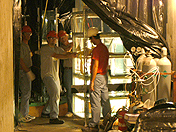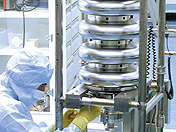Benefits of Particle Physics

Each generation of particle accelerators and detectors builds on the previous one, raising the potential for discovery and pushing the level of technology ever higher. In 1930, Ernest O. Lawrence, the father of particle accelerators, built the first hand-held cyclotron at Berkeley, California. Larger and more powerful accelerators soon followed. After a day's research, Lawrence often operated the Berkeley cyclotrons through the night to produce medical isotopes for research and treatment. In 1938, Lawrence's mother became the first cancer patient to be treated successfully with particles from cyclotrons. Now, doctors use particle beams for the diagnosis and healing of millions of patients. From the earliest days of high-energy physics in the 1930s to the latest 21st-century initiatives, the bold and innovative ideas and technologies of particle physics have entered the mainstream of society to transform the way we live.
Some applications of particle physics—the superconducting wire and cable at the heart of magnetic resonance imaging magnets, the World Wide Web—are so familiar they are almost clichés. But particle physics has myriad lesser-known impacts. Few outside the community of experts who study the behavior of fluids in motion have probably heard of the particle detector technology that revolutionized the study of fluid turbulence in fuel flow.
What is unique to particle physics is the scale of the science: the size and complexity not only of accelerators and detectors but also of scientific collaborations. For example, superconducting magnets existed before Fermilab's Tevatron, but the scale of the accelerator made the production of such magnets an industrial process, which led to the economical MRI machine. The World Wide Web was invented to solve the problem of communicating in an international collaboration of thousands of physicists. The scale on which particle physicists work pushes them beyond what many other sciences do.
Selected examples from medicine, homeland security, industry, computing, science and workforce development illustrate a long and growing list of beneficial practical applications with contributions from particle physics.
For more information about the practical benefits of particle physics visit:
Medicine
Particle accelerators and detectors first developed for particle physics are now used by every major medical center in the nation to treat and diagnose millions of patients.
Homeland security
From scanning cargo in ports to monitoring nuclear waste, the same advanced detector technology that physicists use to analyze particles can also better protect the nation.
Industry
Particle physicists rely on industry to produce and advance the millions of components that experiments require, putting companies on a fast-track towards new products and life-changing technologies.
Computing
To record and analyze the unprecedented volumes of data generated in particle collisions, particle physicists develop cutting-edge computing technology, making key contributions to solutions at the frontiers of computer science.
Sciences
Particle physicists need cutting-edge tools; many of these, such as the synchrotron light source, benefit other areas of science.
Workforce Development
The majority of students who gain their PhDs in particle physics go on to work for high-tech industry, financial institutions and information technology businesses.
A Growing List
The science and technology of particle physics have transformational applications for many other areas of benefit to the nation's well-being.
- Last modified
- 02/09/2016
- email Fermilab








